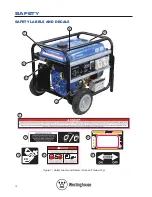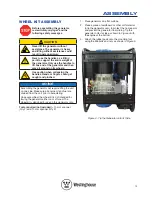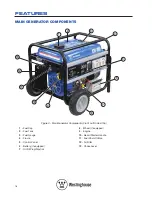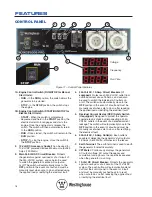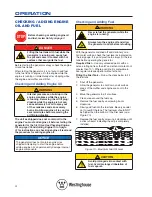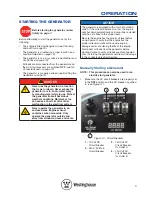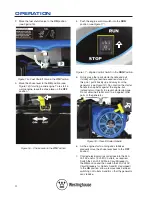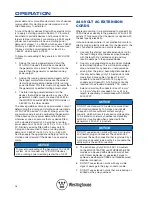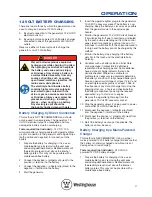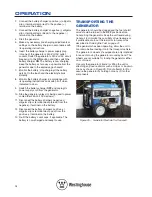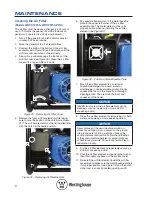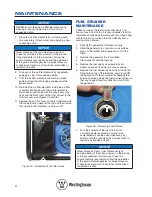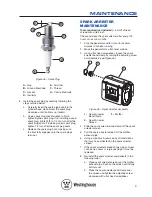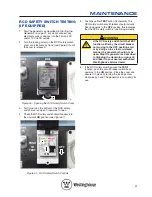
24
OPERATION
OTE:
N
If the engine fails to start after 5 seconds,
release the engine control switch. Let the
generator rest for 15 seconds and then
repeat step 5. If the cranking speed drops
after each unsuccessful attempt, the
battery may not be adequately charged;
manually start the generator as instructed
in Manually Starting a Generator on page
21.
OTE:
N
The electric start generator is equipped
with a battery charging feature. Once
the engine is running, a small charge is
supplied to the battery via the battery
cables and will slowly recharge the battery.
1. As the engine starts and stabilizes, gradually move
the choke lever back to the OFF position.
2. Connect electrical cords or devices into the 240-
Volt AC and/or 12-Volt DC outlets, as required.
Switch the 240-Volt AC Main Circuit Breaker to
the ON position and then switch the 240-Volt AC
Circuit Breakers for Outlets A and B (if equipped)
to the ON position; allow a few seconds between
switching on Outlets A and B so that the generator
can stabilize.
stoPPing tHE gEnErator
Normal Operation
During normal operation, use the following steps to
stop the generator:
1. Switch the 240-Volt AC Circuit Breakers for Outlets
A and B (if equipped) to the OFF position and
then switch the 240-Volt AC Main Circuit Breaker
to the OFF position. Unplug any electrical cords
or devices from the 240-Volt AC and 12-Volt DC
receptacles on the control panel.
2. Allow the generator to run unloaded for at least
one minute to cool and stabilize the engine and
alternator temperatures.
3. Push the engine control switch to the OFF
position.
4. Turn the fuel shutoff valve to the OFF position.
During an Emergency
If there is an emergency and the generator must be
stopped quickly, push the engine control switch to the
OFF position immediately.
aPPliCation anD DutY
CYClE
All models within this range of Westinghouse
generators are portable, air-cooled, petrol-engine
driven, self-contained units designed for independent
supply of electrical power. They are ideal for
applications requiring an occasional backup power
supply in the event of mains power failure such as
home or small business standby duty. They are
equally well suited for remote or on-site applications
such as camping, caravanning and mobile field
service/trade duty that have an intermittent
requirement for electrical power.
Other applications requiring an independent electrical
power supply on a constant 24/7 or frequently
recurring multi-hour basis are better served by
industrial, water-cooled, diesel-engine driven
generators. Typically these are larger and heavier
stationary units that cannot be manhandled and may
require some installation work including connection by
a licensed electrician.
aMBiEnt ConDitions
The generator is designed to operate within the
following range of ambient conditions:
•
Temperature: -5 to +40°C
•
Altitude:
Up to 1,000 m
Where possible, the generator should be operated in
the shade to prevent additional heat load due to solar
radiation.
The engine’s power output will decrease by
approximately 3.5% for each 300 m increase in
altitude above sea level. This is normal for spark-
ignition engines and is attributable to the decrease in
atmospheric pressure (and thus the available air for
combustion) as altitude increases.
ConnECting ElECtriCal
loaDs
The generator can only be used to power 240-Volt AC,
50 Hz, single phase or 12-Volt DC electrical devices.
240-Volt AC Loads
240-Volt AC devices can be connected either directly
or via electrical extension cords into the 240-Volt AC
outlet(s) on the generator’s control panel. Lift up the
spring-loaded weather resistant cover on each outlet
for access to connect the electrical device or cord.
240-Volt AC devices may be fitted with either a three-
pin 15 Ampere (typically abbreviated “15 Amp” or “15
A”) plug or a three-pin 10 Ampere (“10 Amp” or “10 A”)
plug as shown in Figure 23. Certain double-insulated
devices may be fitted with a two-pin 10 A plug that
doesn’t have an earth pin (which is the longer, vertical
pin).
Summary of Contents for WHXC3750
Page 4: ...4...
Page 55: ...55 NOTES...

